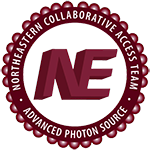Publications
(2013) Alteration in the cavity size adjacent to the active site of RB69 DNA polymerase changes its conformational dynamics. Nucleic Acids Res. 41, 9077-89
(2011) Hydrogen-bonding capability of a templating difluorotoluene nucleotide residue in an RB69 DNA polymerase ternary complex. J Am Chem Soc. 133, 10003-5
(2012) Bidentate and tridentate metal-ion coordination states within ternary complexes of RB69 DNA polymerase. Protein Sci. 21, 447-51
(2013) DNA mismatch synthesis complexes provide insights into base selectivity of a B family DNA polymerase. J Am Chem Soc. 135, 193-202
(2012) Contribution of partial charge interactions and base stacking to the efficiency of primer extension at and beyond abasic sites in DNA. Biochemistry. 51, 4922-31
(2014) Mispairs with Watson-Crick base-pair geometry observed in ternary complexes of an RB69 DNA polymerase variant. Protein Sci. 23, 508-13
(2012) Structural basis for differential insertion kinetics of dNMPs opposite a difluorotoluene nucleotide residue. Biochemistry. 51, 1476-85
(2012) Probing minor groove hydrogen bonding interactions between RB69 DNA polymerase and DNA. Biochemistry. 51, 4343-53
(2011) Variation in mutation rates caused by RB69pol fidelity mutants can be rationalized on the basis of their kinetic behavior and crystal structures. J Mol Biol. 406, 558-70
(2012) Using a fluorescent cytosine analogue tC(o) to probe the effect of the Y567 to Ala substitution on the preinsertion steps of dNMP incorporation by RB69 DNA polymerase. Biochemistry. 51, 4609-17
(2011) Structural insights into complete metal ion coordination from ternary complexes of B family RB69 DNA polymerase. Biochemistry. 50, 9114-24
(2004) Structural basis for allostery in integrins and binding to fibrinogen-mimetic therapeutics. Nature. 432, 59-67
(2017) How type II CRISPR-Cas establish immunity through Cas1-Cas2-mediated spacer integration. Nature. 550, 137-141
(2019) Human cGAS catalytic domain has an additional DNA-binding interface that enhances enzymatic activity and liquid-phase condensation. Proc Natl Acad Sci U S A. 116, 11946-11955
(2020) Structure-function analysis of microRNA 3'-end trimming by Nibbler. Proc Natl Acad Sci U S A. 10.1073/pnas.2018156117
(2020) Structure-function analysis of microRNA 3'-end trimming by Nibbler. Proc Natl Acad Sci U S A. 10.1073/pnas.2018156117
(2023) Arabinose- and xylose-modified analogs of 2',3'-cGAMP act as STING agonists. Cell Chem Biol. 10.1016/j.chembiol.2023.07.002
(2021) Molecular mechanisms of assembly and TRIP13-mediated remodeling of the human Shieldin complex. Proc Natl Acad Sci U S A. 10.1073/pnas.2024512118
(2018) Structures of chaperone-substrate complexes docked onto the export gate in a type III secretion system. Nat Commun. 9, 1773
(2022) Emerging enterococcus pore-forming toxins with MHC/HLA-I as receptors. Cell. 185, 1157-1171.e22
(2018) Structural Basis for Auto-Inhibition of the NDR1 Kinase Domain by an Atypically Long Activation Segment. Structure. 26, 1101-1115.e6
(2017) Discovery of Potent and Selective Inhibitors for G9a-Like Protein (GLP) Lysine Methyltransferase. J Med Chem. 60, 1876-1891

